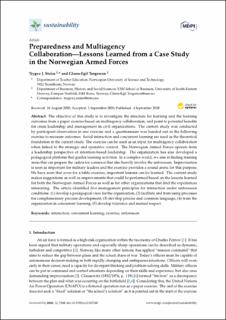| dc.contributor.author | Steiro, Trygve | |
| dc.contributor.author | Torgersen, Glenn-Egil | |
| dc.date.accessioned | 2020-09-28T07:46:49Z | |
| dc.date.available | 2020-09-28T07:46:49Z | |
| dc.date.created | 2020-09-09T08:56:15Z | |
| dc.date.issued | 2020 | |
| dc.identifier.issn | 2071-1050 | |
| dc.identifier.uri | https://hdl.handle.net/11250/2679838 | |
| dc.description.abstract | The objective of this study is to investigate the structure for learning and the learning outcomes from a paper exercise based on multiagency collaboration, and point to potential benefits for crisis leadership and management in civil organizations. The current study was conducted by participant observation in one exercise and a questionnaire was handed out in the following exercise to measure outcomes. Social interaction and concurrent learning are used as the theoretical foundation in the current study. The exercise can be used as an input for multiagency collaboration when linked to the strategic and operative context. The Norwegian Armed Forces operate from a leadership perspective of intention-based leadership. The organization has also developed a pedagogical platform that guides learning activities. In a complex world, we aim at finding training areas that can prepare the cadets for scenarios that also heavily involve the unforeseen. Improvisation is seen as important for military leaders and the exercise provides a sound arena for this purpose. We have seen that even for a table exercise, important lessons can be learned. The current study makes suggestions as well as improvements that could be performed based on the lessons learned for both the Norwegian Armed Forces as well as for other organizations that find the experiences interesting. The article identified five management principles for interaction under unforeseen conditions: (1) develop a pedagogical view for the organization, (2) facilitate and train using processes for complementary process development, (3) develop precise and common language, (4) train the organization in concurrent learning, (5) develop tolerance and mutual respect. | en_US |
| dc.language.iso | eng | en_US |
| dc.publisher | MDPI | en_US |
| dc.rights | Navngivelse 4.0 Internasjonal | * |
| dc.rights.uri | http://creativecommons.org/licenses/by/4.0/deed.no | * |
| dc.title | Preparedness and Multiagency Collaboration—Lessons Learned from a Case Study in the Norwegian Armed Forces. | en_US |
| dc.type | Peer reviewed | en_US |
| dc.type | Journal article | en_US |
| dc.description.version | publishedVersion | en_US |
| dc.source.volume | 12 | en_US |
| dc.source.journal | Sustainability | en_US |
| dc.source.issue | 18 | en_US |
| dc.identifier.doi | doi.org/10.3390/su12187240 | |
| dc.identifier.cristin | 1828255 | |
| dc.description.localcode | This is an open access article distributed under the Creative Commons Attribution License which permits unrestricted use, distribution, and reproduction in any medium, provided the original work is properly cited | en_US |
| cristin.ispublished | true | |
| cristin.fulltext | original | |
| cristin.qualitycode | 1 | |

